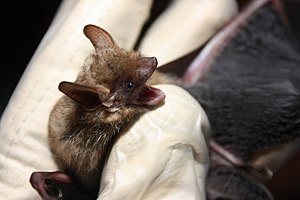Eastern American pipistrelle
| Eastern American pipistrelle | ||||||||||||
|---|---|---|---|---|---|---|---|---|---|---|---|---|

Eastern American pipistrelle ( Perimyotis subflavus ) |
||||||||||||
| Systematics | ||||||||||||
|
||||||||||||
| Scientific name of the genus | ||||||||||||
| Perimyotis | ||||||||||||
| Menu , 1984 | ||||||||||||
| Scientific name of the species | ||||||||||||
| Perimyotis subflavus | ||||||||||||
| ( Cuvier , 1832) |
The Eastern American pipistrelle ( Perimyotis subflavus ) is a bat species from the smooth-nosed family (Vespertilionidae). It is native to North America in the north of Central America. The species name subflavus is Latin and means something like "yellowish". A synonym for the species is Pipistrellus subflavus .

description
The Eastern American pipistrelle bat is a small bat with an overall length of 77 to 89 mm, a forearm length of 31.4 to 34.1 mm and a weight of 4.6 to 7.9 g. It differs from small species of the genus of the mouse ears ( Myotis ) by the three-colored hairs, which are dark at the base and the tip, but light brown-yellow in the middle. The coat color generally ranges from yellow-orange to a dark mahogany brown. It differs from the Western American pipefish bat ( Parastrellus hesperus ), the range of which partially overlaps with that of the Eastern American pipistrelle, by the larger foot (more than half as long as that of the lower legs) and the longer thumb (> 4.9 mm ).
The eastern American pipistrelle is one of the few bat species in which animals with additional limbs ( polydactyly ) were found, for example in 1958 in a female who had six toes per foot and two thumbs on each hand.
Way of life
The eastern American pipistrelle, like most bats, is nocturnal and feeds on insects. It often hunts over bodies of water and at forest edges. She is a relatively slow (approx. 18.7 km / h) and agile aviator. The diet consists mainly of beetles (Coleoptera), constant- winged animals (Homoptera), two-winged animals (Diptera) and hymenoptera (Hymenoptera), with smaller prey animals being preferred. The echolocation calls range between 19 and 35 kHz and are therefore partially audible to the human ear.
Eastern Eurasian Pipebats also hibernate in warmer areas . In autumn, the animals eat their fat reserves, which they lose again during the hibernation period between September and April. The average weight loss is 29% in females and 39% in males. Due to its small size, the Eastern Pipistrelle can overwinter in caves, mines and buildings with higher ambient temperatures than other bats. In the same hibernation places but there are also many other bats as the Little Brown Bat ( Myotis lucifugus ), the Keen mouse ear ( Keen's Myotis ), M. solo dalis , M. austroriparius , the Gray Mouse ear ( M. grisens ) and the big brown bat ( Eptesicus fuscus ). During hibernation, Eastern American Pipebats do not maintain body contact with each other, but hibernate individually. Like many other North American bat species, they can be attacked by white nose syndrome , a fungal disease with a high mortality rate.
After hibernating, Eastern American piped bats migrate to the so-called mother rooms, which are often located in barns, attics and other buildings. The males spend the summer individually, while the females raise their young in colonies. During the day, single males are usually found under loose tree bark, in tree hollows and crevices. The oldest animal ever caught was a 14.8 year old male.
Reproduction
Eastern American pipitic bats mate in the fall. During hibernation, the females store the sperm in the uterus . The ovulation and subsequent fertilization will find place only in the spring. After a gestation period of around 44 days, the females in the motherhouse usually give birth to two young animals, separated from the males. The young together weigh up to 52% of the weight of a full-grown bat. Newborns are hairless, the skin is pink, the eyes are closed and the auricle is folded up. In the period after birth, the young animals gain an average of 0.15 g in weight per day. The females recognize their young from a distance by their loud calls. At the age of 3 weeks, the young animals begin their first attempts to fly and a week later they start looking for food independently. After 45 days, the young reach their full size and can only be distinguished from the adult animals by the epiphyseal plates . Usually only one of the two young in a litter survives.
distribution and habitat
The Eastern American pipistrelle is found from the east coast of the United States to Minnesota , Nebraska , and Kansas , in southeastern Canada , and on the east coast of Mexico to Honduras . Its population is classified as safe by the IUCN thanks to its wide distribution area.
literature
- RM Warner & NJ Czaplewski (1984): Pipistrellus subflavus . In: Mammalian Species , No. 228, pp. 1-4
swell
- ^ Menu, H. 1984. Revision du Statut de Pipistrellus subflavus (F. Cuvier, 1832). Proposition d'un Taxon Generique Nouveau: Perimyotis Nov. Gen. Mammalia 48 (3): 409-416. doi: 10.1515 / mamm.1984.48.3.409
- ↑ MacDonald, K., Matsui, E. Stevens, R. & Fenton, MB (1994): Echolocation calls and field identification of the eastern pipistrelle (Pipistrellus subflavus: Chiroptera: Vespertilionidae), using ultrasonic bat detectors. Journal of Mammalogy, 462-465.
- ↑ Blehert, DS et al. (2009): Bat white-nose syndrome: an emerging fungal pathogen? Science, 323 (5911), 227-227.
- ↑ Hoying, KM & Kunz, TH (1998): Variation in size at birth and post ‐ natal growth in the insectivorous bat Pipistrellus subflavus (Chiroptera: Vespertilionidae). Journal of Zoology, 245 (1), 15-27.
- ↑ Perimyotis subflavus in the IUCN Red List of Threatened Species .
